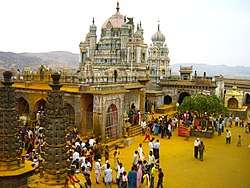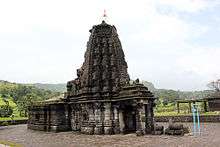Shivleni Caves
| Shivleni Caves | |
|---|---|
| Jogai Mandap | |
 Inner view of Shivleni | |
 | |
| Nearest city | Ambajogai, Maharashtra, India |
| Coordinates | 18°44′21″N 76°23′11″E / 18.739166°N 76.3862987°E |
The Shiv leni Caves (Shiva leni; Jogai Mandap; Hattikhana) in Ambajogai, Maharashtra of Maharashtra, India are rock-cut cave monuments[1] which date in King Udayaditya (reigned c. 1060–1087) to about "In all, total excavations were hewn out of rock cut and carved deep inside the hill", The caves include sculptures described by the government Archaeological Survey of India as "the finest surviving examples of Indian art", which are masterpieces with figures of the Hindu and depictions of the 'Hindu Puraan' tales.

The site is a listed in "List of State Protected Monuments in Maharashtra" - protected monument in the care of the Department of Archaeology of Maharashtra, India,[2] under the Maharashtra Ancient Monumnets and Archeological Sites & Remains Act, 1960, the Shivleni Caves (Jogai Mandap) have been a Archaeological Survey of India Heritage Site.
About
Shivleni (Jogai Sabhamandap) Cave are situated hardly half a kilometer to the north-west of Yogeshvari Temple, along the banks of the river Jayvanti. The caves are squares in shape and are carved deep inside the hill. On the southern side of the hill is the entrance. Inside mandap(pavilion) has an 8.36 sq m. court-yard in front and inside the roof is supported by four pillars.
Inside Caves
In the centre of the court-yard there is an elegantly carved nandimandap measuring 9.14x9.14 meters. In the center of this mandap there is an image of nandi. The inside of the cave is impressive; one hall is supported by thirty two pillars and adorned with sculptures of Shiva and Ganesha.
History and Inscription
A inscription found here dated Saka 1066 records the grant as inams for the maintenance of these caves by the Rastrakuta king Udayaditya who was Mahamandalesvar. This inscription has been removed to the Tahsildar's office at Ambajogai for safe custody and preservation.
There is a local story related to the monument. Which says that the monument is the wedding court of the jogaidevi, whose temple is situated nearby. It is said that the wedding was planned to take place in this mandap but couldn't take place due to some super natural reasons and the elephants and everything inside it turned to stone. That is why the name 'Jogai Mandap' is given to it.
There is also a local belief that there is an underground tunnel in this Hattikhana which leads to Parli Vaijanath, which is around 25 km from there. But it was believed to have been shut down by the authorities.
Protection
The monument is now a state protected monument under the Maharashtra Ancient Monuments and archaeological sites & Remains Act, 1960.
References
- ↑ "Shivleni - Jogai Mandir Cave Temple, Ambajogi". Retrieved 23 Jan 2015.
- ↑ "General view of the Jogai Mandir Cave Temple, Ambajogi". Retrieved 23 Jan 2015.

